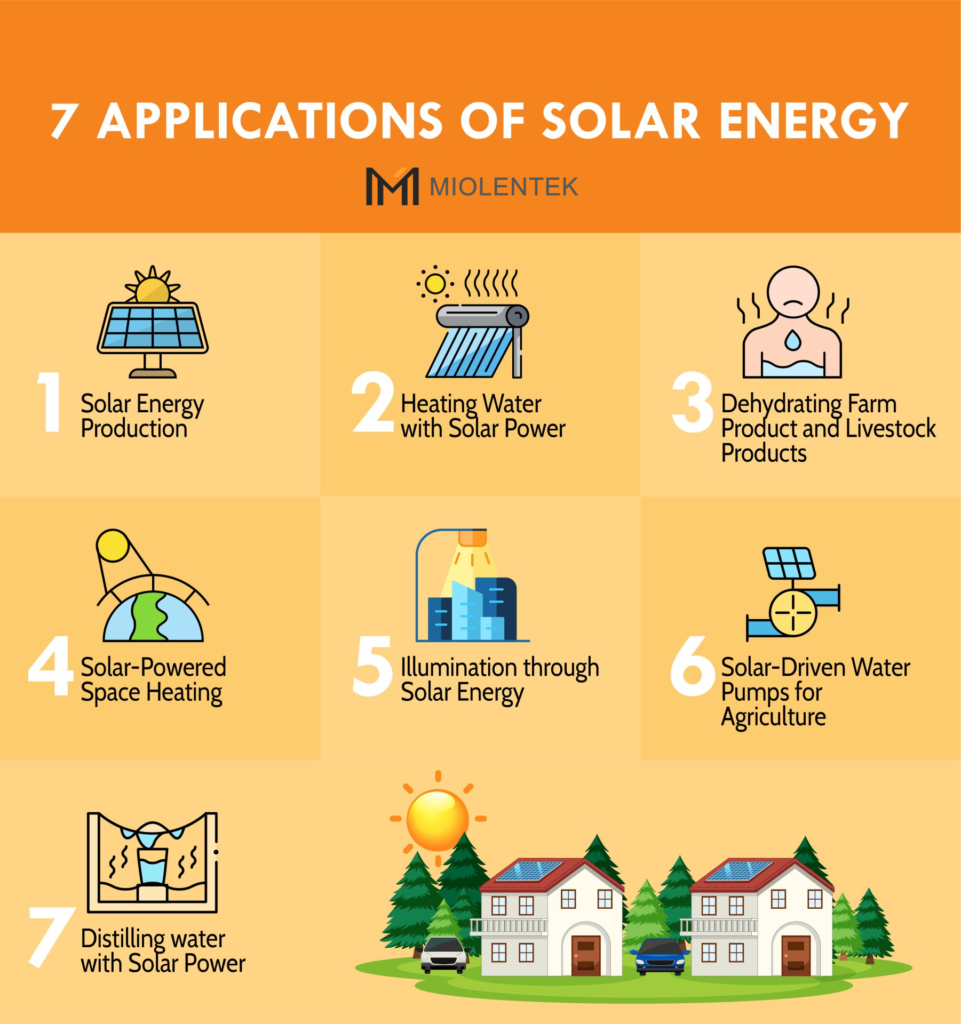Solar energy application
Solar energy is a very beneficial and practical energy source that typically utilizes its two main forms: heat and light. We use solar energy to charge vehicles, generate electricity from photovoltaic (PV) cells and heat water.
- Solar power generation (electricity)
The falling price of solar panels and their improved durability has prompted more people to choose them as an alternative for powering homes and industries.
Solar energy generates electricity through photovoltaic cells, which convert direct sunlight into electricity. The energy generated by solar power systems can be used to offset or even completely replace a user’s monthly electricity bill.
Excess electricity can be sent to the grid for use by other local consumers. When it comes to solar power, you can choose between grid-tied and off-grid systems. Off-grid systems rely solely on solar energy and do not connect to a utility company or use electricity.
The system is connected to solar cells to ensure backup power operation at night, on cloudy days and in emergencies.
Grid-tied systems, on the other hand, connect to the solar system and utility company power, fluctuating between the two based on conditions and demand.
Excess energy generated by solar energy can be stored in battery banks, but can also be fed back into the grid, where the electricity provider distributes it to other customers, which can go a long way toward offsetting your electricity bill.
If your solar system is unable to generate electricity, the power company can meet your power needs.
- Water heating
Solar energy is commonly used to heat water in our homes, industries, hotels and even hospitals.
Homeowners use rooftop photovoltaic cells (PV) to absorb the sun’s heat and heat water in an insulated water tank, which can store hot water for considerable periods of time for home use.
Solar systems can also heat the pool by circulating water through solar collectors and heating it with sunlight before it can be used again in the pool.

- Drying of agricultural and livestock products
Solar energy can also be used to dry fruits, milk, fish, potato chips, corn kernels and other agricultural and livestock products.
The product is placed in a cabinet dryer, which consists of a box with an insulated base, painted black on the inside and covered with sloping transparent panels.
Ventilation holes are perforated on the bottom and top to allow air to circulate over dry materials, and are located on perforated trays inside the cabinet.
- Solar heating
You can use solar energy to heat your home and business. Devices such as flat plate collectors convert solar radiation into heat (thermal energy).
The flat plate collector consists of a black metal plate with a transparent glass cover on top and an insulation layer below it, which can be heated by sunlight.
Metal collectors absorb the sun’s heat and transfer it to water or air as a carrier fluid, which flows through the plates to an insulated water tank that stores hot or warm water.
This hot water system can also provide your home with hot or warm water that flows through ceiling or floor pipes.
When a building requires heat, hot water or air can be transferred from these collectors or devices to the interior spaces of the building through traditional equipment such as fans, vents, and ducts.
- Solar lighting
Solar energy is a suitable solution for security lights, street lights, indoor lights and road signs as they are affordable, environmentally friendly and easily available.
You can use solar energy to light up your home or business because it is a great option to save electricity, energy, and costs without dissipating or losing power like other energy systems.
6.Solar pumped irrigation
The solar energy generated by the solar panel system can be used to pump water for irrigation during the summer.
During hot seasons, crops lose more water through the process of transpiration, but at the same time, solar panels produce more solar energy because they are exposed to greater amounts of sunlight. This makes solar solutions ideal for irrigation purposes as it is readily available and affordable.
- Solar water distillation
Solar energy can greatly help distill water, especially in arid, semi-arid or coastal areas with salt water and lots of sunshine. Sunlight from these areas can be used to convert salt water into purified water for drinking.
Solar heat is transferred through clear glass into a light black basin filled with salt water. Thermal radiation is absorbed and converted into heat in the blackened bay.
The heat evaporates from the brine, and the pure water in the brine condenses into pure water in the form of steam, which is collected in basins and transferred to tank storage
